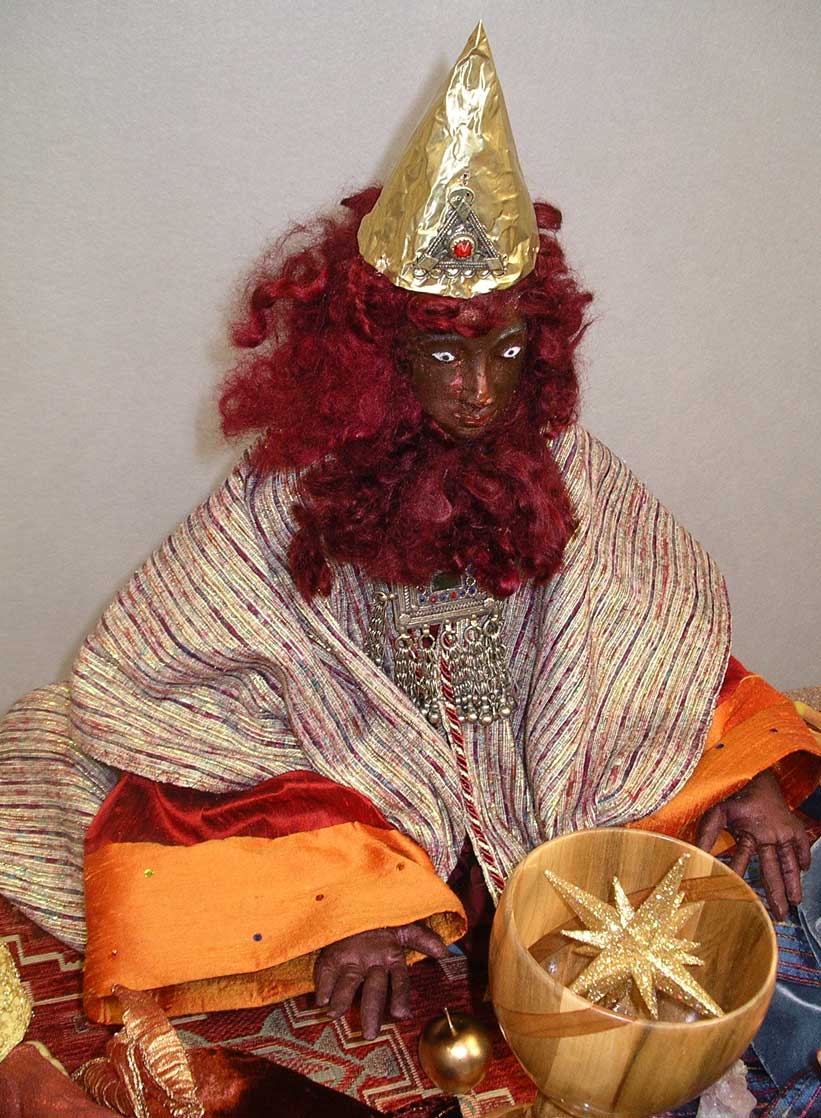FiberAlchemy.com
The Shekinah/Queen of Heaven and Four of the Magi
The male Magi wear elegant tunics, cloaks, and pants, made of silks and velvets, embellished with Swarovski™ crystals, embroidered trims, and gold stampings. They also have necklaces (pearls, crystals, stone, ethnic, etc.) and rings. The female Magus wears a silk dress edged in gold trim and a rust-colored panné velvet tunic. A golden, faceted crystal globe hangs from a chain around her neck.
The Shekinah/Queen of Heaven is cloaked in grey and white chiffons and a handmade, Angelina-fiber veil. The carpet is tapestry upholstery material. In the center is a handmade olivewood chalice; resting inside it is a many-pointed, glittering star.
According to the biblical text (Matthew 2:1-2), the Magi (often inaccurately identified as Wise Men or even kings) came from the East, following a star (a.k.a. the Star of Bethlehem; another translation is, “his star in the ascendant”). They bore three gifts: gold (representing Jesus’ kingship), frankincense (representing his priesthood), and myrrh (representing his death) (Matthew 2:11). Because they bore three gifts, Western tradition says there were three (a number popularized by the lovely Christmas carol, “We Three Kings…,” written in 1857 by an American minister, John Henry Hopkins Jr.)—but other traditions say they numbered from two to twelve.
Some legends say the three represented three different nationalities and three ages of man: young, middle, and old. In the West, five centuries after Jesus’ death, they became known as Casper or Gaspar (often depicted as Oriental), who gave incense; Melchior (light-skinned), who offered gold; and Balthasar (depicted as a young African or Moor), who offered myrrh. Or, in another tradition, Balthasar was thought to be king of Arabia, Melchior of Persia, and Gaspar of India.
The Greek term Magi is more accurately translated as “Persian Court Officials,” gender not specified. They were probably astrologers, knowledgeable in reading the stars, able to recognize an unexpected stellar event—a comet, perhaps, streaking across the sky. Because the Greek word “magi” is gender neutral, and the names, number, and gender are not specified, in 2004 the Anglican Communion declared that these visitors from the East could have been women. At any rate, calling them “Three Kings” is both inaccurate and biased.
I decided to create four Magi, one of which is female, to indicate that a number other than three is possible. The three male figures represent three different ages; the four figures represent the four “races” of humanity and the four elements: red for fire; yellow for earth; blue for air; and green for water.
My meditation had not told me to what or whom the Magi brought their gifts, but I had seen the gifts: a lily, a rose, an emerald, and a golden apple. But to what or whom did they offer them? At last it came to me: to a chalice, a holy grail filled with the light of a star—the Star they have followed from the East, the Star of the Divine Light within….
Questions are raised: What does it mean to be wise? What does a wise person seek? And what do they find? What do you seek? What star do you follow? And where does it lead?
Watching over them, the Shekinah, God’s manifestation, the Feminine Presence, the Queen of Heaven—witnesses their presence as they kneel before that which they have sought…





